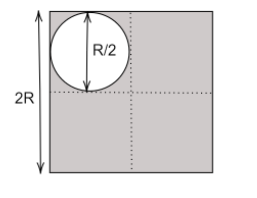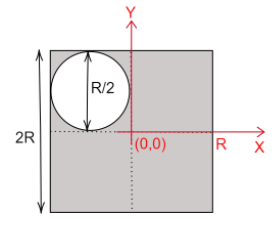Question
Question: A uniform square sheet has a side length of \(2\;R\). A circular sheet of the maximum possible area ...
A uniform square sheet has a side length of 2R. A circular sheet of the maximum possible area is removed from one of the quadrants of the square sheet. The distance of the centre of mass of the remaining portion for, the centre of the original sheet is-
(A) 2[16−π]πR
(B) 16−πR
(C) π[16−π]R
(D) 16−πRπ
Solution
To calculate the distance between the centre of masses in both cases, we consider the circular cut-out section as a separate mass and the rest of the square as a separate second mass. For ease in calculation, assume origin at the centre.
Formula used:
CMx=m1+m2+...+mnm1x1+m2x2+...+mnxn
where, CMx is the centre of mass along the X-axis of a body (similar for Y-axis)
miis the mass of ith point mass of the distributed system.
xi is the distance of ith point mass of the distributed system.
Complete step by step solution:

In the given figure, the white circle represents the cutout area, while the grey portion represents the remaining part of the square.
Let us consider the circle as Aand the rest portion of the square as B.
We also assume that the origin is situated in the centre of the square.

For the square,
The figure is symmetrical about both axes, therefore the center of mass is situated at the midpoint of a given side.
The X-coordinate is Xˉ=0
The Y coordinate is Yˉ=0
The centre of mass of the square sheet while still intact is at- (0,0) which is the origin.
Since it is given that the distribution of mass in the sheet is uniform, the mass density (mass per unit area) is constant.
Let ρ be the mass per unit area of the sheet. Then,
M=ρa
where Mis the mass and a is the area of a given part of the sheet.
The center of mass of a part can now be written in terms of ρ and a as-
CMx=ρa1+ρa2+...+ρanρa1x1+ρa2x2+...+ρanxn
⇒ CMx=a1+a2+...+ana1x1+a2x2+...+anxn
Now if the square sheet is cut into two parts A and B then,
For part A (circular part) the maximum area is possible when the diameter of the circle is R, in that case, the centre of mass is situated at the geometrical centre of the circle itself,
With respect to the origin, this distance is,
XˉA=2R
YˉA=2R
For part B (leftover part) we assume that the distance of center of mass from the origin is-
XˉB=xB
YˉB=yB
We know that the combination of A and B gives the square whose center of mass is (0,0),
Thus equating both of these quantities-
In X-axis,
0=aA+aBaAxA+aBxB
⇒−aAxA=aBxB
Rearranging,
xB=aB−aAxA
The area aA=4πR2
xA=2R (calculated previously)
And,
aB=(2R)2−4πR2
(obtained by subtracting the area of a circle from the area of square)
aB=416R2−πR2
The centre of mass,
xB=416R2−πR2−(4πR2)(2R)
Upon simplifying the equation we get,
xB=8(16R2−πR2)−4(πR3)
⇒xB=2(16−π)−πR
Repeating similar steps for the centre of mass along Y-axis, we get-
yB=2(16−π)πR
Thus the distance of the centre of mass for the new portion from the old centre of mass (origin)-
D=xB2+yB2
Putting the values in this equation,
D=(2(16−π)−πR)2+(2(16−π)πR)2
Upon simplifying the equation we get,
D=(2(16−π)2πR)
⇒D=2(16−π)πR
Hence, option (A) is the correct answer.
Note: A similar approach to this approach, called the “Negative mass” method is also used to calculate the centre of mass of the object when a uniform shape is cut out of a solid object. Mass cannot be negative in real life, but the removed mass may be considered as Negative mass in the calculations.
